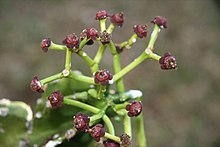This article's tone or style may not reflect the encyclopedic tone used on Wikipedia. (November 2023) |
Euphorbia tanaensis, commonly known as the Tana River euphorbia, is a critically endangered flowering plant within the family Euphorbiaceae. This species is endemic to a specific location along the Tana River in Kenya. Discovered initially as a group of nine specimens in 1988, a follow-up survey conducted in 2006 found only four remaining individuals, with no evidence of natural regeneration. The habitat of Euphorbia tanaensisis is currently under threat from ongoing deforestation.[1]
| Euphorbia tanaensis | |
|---|---|

| |
| Scientific classification | |
| Kingdom: | Plantae |
| Clade: | Tracheophytes |
| Clade: | Angiosperms |
| Clade: | Eudicots |
| Clade: | Rosids |
| Order: | Malpighiales |
| Family: | Euphorbiaceae |
| Genus: | Euphorbia |
| Species: | E. tanaensis
|
| Binomial name | |
| Euphorbia tanaensis | |
Description edit
Euphorbia tanaensis is characterized as a medium-sized succulent, which can reach heights of up to 30 meters tall. It has a single trunk that may attain a diameter nearing 50 centimeters. The flowers are diminutive and clustered into inflorescences known as Cyanthia.[3]
Distribution and habitat edit
Euphorbia tanaensis is endemic to Witu, Kenya. Its estimated distribution range is confined to an area of approximately 4 km² (1.5 sq mi) where it grows on the periphery of wet lowland forests, particularly those dominated by Terminalia zambesiaca. This specific ecological niche contributes to the plant's distinct characteristics and vulnerability.[1]
Conservation edit
Euphorbia tanaensis is listed as Critically Endangered by the International Union for Conservation of Nature (IUCN). Within its endemic habitat, the population is estimated to comprise only four mature individuals. There are no records of this species in protected areas or ex situ conservation collections, and there has been no observed evidence of regeneration among the existing population.
Concerted efforts by community groups and forestry organizations have been made to restore the population. Notably, in 2018 several nursery-raised seedlings were planted in Witu and Kilifi’s Arabuko Sokoke forests.[4]
As of August 2023, the Kenya Forestry Research Institute (Kefri) has engaged in captive cultivation of the plant in an effort to restore its population.
Threats edit
The primary threats to Euphorbia tanaensis are predominantly from human activities, particularly intensive logging within its habitat. Evidence of human disturbance, such as pole-cutting and the use of pit saws, have been observed close to its habitat. These disturbances are suspected to be a contributing factor to the species’ decline.[1]
References edit
- ^ a b c d Beentje, H.J.; Gereau, R.E.; Hilton-Taylor, C.; Howard, G.; Kindeketa, W.; Luke, W.R.Q.; Maunder, M.; Mwachala, G.; Mwangoka, M.; Ndangalasi, H.; Njau, E.-F.; Schatz, G.E.; Siro Masinde, P.; Wilkins, V.L. (2020). "Euphorbia tanaensis". IUCN Red List of Threatened Species. 2020: e.T30898A2798380. doi:10.2305/IUCN.UK.2020-3.RLTS.T30898A2798380.en. Retrieved 16 November 2021.
- ^ "Euphorbia tanaensis". Plants of the World Online. Royal Botanic Gardens, Kew. Retrieved 22 February 2024.
- ^ "Euphorbia tanaensis P. R. O. Bally & S. Carter articles - Encyclopedia of Life". eol.org. Retrieved 2023-12-29.
- ^ Report, Staff (2023-08-23). "The Spectacular Revival of Euphorbia Tanaensis in Witu Forest". The Farmer's Journal Africa. Retrieved 2024-04-12.
